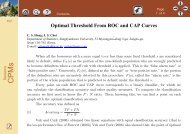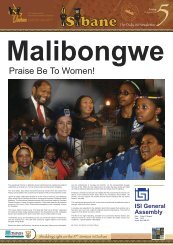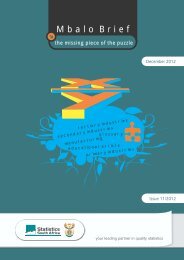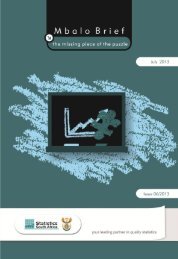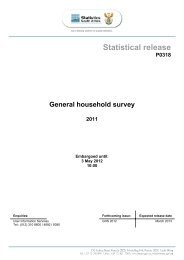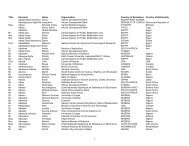Post-enumeration Survey (PES) - Statistics South Africa
Post-enumeration Survey (PES) - Statistics South Africa
Post-enumeration Survey (PES) - Statistics South Africa
Create successful ePaper yourself
Turn your PDF publications into a flip-book with our unique Google optimized e-Paper software.
<strong>Statistics</strong> <strong>South</strong> <strong>Africa</strong><br />
41<br />
Table 9: Probabilities of inclusion and omission of a person – in-scope sub-universe<br />
Probability of being included in Census 0,845193<br />
Probability of being included in <strong>PES</strong> 0,815745<br />
Probability of being included in both Census and <strong>PES</strong> 0,689462<br />
Probability of being included in Census, but missed in <strong>PES</strong> 0,155731<br />
Probability of being included in <strong>PES</strong>, but missed in Census 0,126283<br />
Probability of being missed in both census and <strong>PES</strong> 0,028524<br />
6.2 Estimation of the net undercount rate<br />
The net undercount (or overcount) is the difference between the estimated true population (dual-system<br />
estimate) and the estimated census population. The rate is the net undercount expressed as a<br />
percentage of the estimated true population. The net undercount rates, together with their absolute<br />
errors and confidence intervals, are shown in the following tables for geographic and demographic<br />
groups. The confidence interval is formed around the estimate by adding or subtracting the absolute<br />
error. It must be noted that high absolute errors indicate that the estimate is not statistically reliable and<br />
confidence intervals are very wide as a result.<br />
In Table 10, it can be observed that the net undercount rate at the national level was estimated at 14,6%,<br />
with confidence intervals ranging from 14,34 and 14,86. When comparing rates for different sets of<br />
persons, the confidence intervals must be taken into account. Before concluding that a 'differential'<br />
undercount exists, for example, that the undercount rate for one group is in fact higher (or lower) than<br />
that of another group, the two confidence intervals in question must not overlap. (This is equivalent to a<br />
two-tailed hypothesis test at the 0,05 level of significance.) An overlap in the intervals indicates that –<br />
except for a 5% chance of erring in the conclusion – the difference observed is not statistically significant<br />
due to random error; in other words, that there is no evidence of a real difference. A 'floating bars' chart<br />
is useful for visualising the intervals (see Figure 7).<br />
<strong>Post</strong> Enumeration <strong>Survey</strong> (<strong>PES</strong>)



